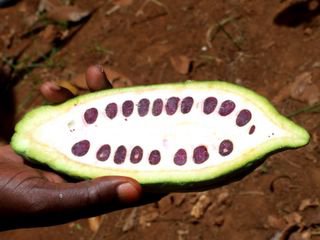Thursday, November 03, 2005
Tuesday, August 09, 2005
Market in Uganda

This roadside market in Uganda sells all types of fruits and vegetables grown by women in their yards. These stands are found in rural areas and in cities, both large and small, all over Africa. And the prices are usually better than you would pay in the supermarket in larger African cities.
Aren't the hills in the distance lovely?
Me Driving a Matatu in Africa
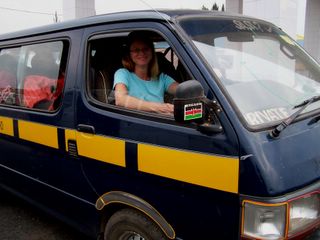
I recently took a trip from Kenya to the Congo with friends and co-workers. We rented this van (matatu) and drove through Uganda, Rwanda and the Congo. Notice how the steering wheel is on the right side of the vehicle. This is how the vehicles are in Kenya. They also drive on the left side of the road (like the British), whereas folks in North America drive on the right side of the road.
When we got to Rwanda and the Congo, I drove because no one else knew how to drive on the right side of the road like we do in the U.S. I enjoyed driving, even though the roads can be very bad with huge holes. I even enjoyed driving on the left side of the road in Uganda. We made it back to Kenya safely. You can see photos of the countries we visited on this blog.
Monday, August 08, 2005
Rwandan Mountainscape with Banana Groves
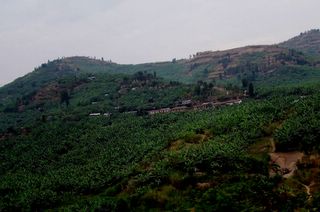
In Rwanda, many types of bananas are grown. Finger bananas, larger sweet (yellow) bananas and green bananas used strictly for cooking. When green bananas are stewed, they taste just like stewed potatoes.
People in Rwanda and other central African countries grow fields and fields of bananas to sell and many people grow a few trees in their yard for their own use.
Tailor Shop in Uganda

This shop, on the highway, sells clothes made by tailors. There is a woman sitting at a sewing machine under the shelter (click on the pic to see her better). The clothes on display are for sell.
If they want something made just for them, people can pick out the fabrics they like and the woman will make a dress or suit to fit the customer's wishes.
Sunday, August 07, 2005
Mama with Children

Women all over Africa carry things on their heads. They also wrap and tie their babies to their backs. Women in different countries tie their babies on in different ways. This woman doesn't have her child tied on (usually it's just the infants who are wapped), but you can see the younger girl has a baby tied to her back.
It's common to see children aged four years and older carrying their baby brothers and sisters on their backs. Young children also learn to carry things on their heads. Water is carried most often, but they also carry firewood, baskets of vegetables and fruits and even school books.
Janine with her Jiko (Charcoal) Stove

Janine is a Professor of Law at the University of Free States in the Congo. She grew up in Cameroon, a central African country where they speak French, just as they speak it in the Congo. But Janine speaks English, too. This is the jiko stove she keeps on her back porch for cooking. The coal goes in the bottom and pots on top cook all types of food. Some people even bake cakes on their jikos!! The put the cake pan with batter inside a large pan and then put a lid on it, to capture the heat and bake the cake, or even bread. Not many people in Africa have stove with burners on top and an oven underneath.
Saturday, August 06, 2005
Rose Prepares Green Bananas for Frying

Rose is a student studying law at the University of Free States in the Congo. She is cutting up green bananas and will deep fry them in hot oil. She's also cooking fried fish. There's a piece of white fish on the plate in the photo. Lake Kivu is a five-minute walk from the university so fresh fish is plentiful.
Rose is from the Congo and she speaks French, though she knows a little English, too. She and her friends like to dip their fried bananas in mayonnaise. I tried it and it was quite tasty. The entire dinner was delicious!
Mountain in Rwanda

Rwanda is a very small country but it is covered in thousands of mountains, like this one. Notice how the hill side is cultivated in rows of crops. With nearly nine million people in a 10,000 square mile country, very little land is left uncultivated. People live together in small communities. Very few of them live on the mountain sides where they farm. But each family has their plot of land on the mountain slope and they walk to their "farm" daily to tend to crops so their family will have food to eat and sell.
Friday, August 05, 2005
Casava Trees in Uganda

Casava, pronounced ka-sa-va, is the root of the trees shown in this photo. The casava vegetable tastes very much like potato and is cooked like potatoes are cooked; Africans boil them, fry them, make chips and french fries, stew them and cook them with different meats. Many people in equatorial Africa grow casava in their yards for their own consumption.
Thursday, August 04, 2005
Tea Fields in Rwanda

This photo shows the early morning mist that settles in the valleys of Rwanda. Tea grows very well in this fertile and moist country. Tea plants have lovely, light green leaves on top. When the tea is ready to be harvested, men and women move amongst the bushes and pick the most tender leaves by hand. The leaves are then processed and packaged, sometimes into the little tea bags you buy from the store. They're then exported to countries around the world. But this is where they get their start, in the gorgeous, misty valleys of Rwanda and other East and Central African countries.
Monday, August 01, 2005
Finger Bananas

These small bananas grow all over tropical Africa. They're called Finger Bananas because they're about the length of a finger, as you can see from my hand in the photo. They taste just like the larger bananas.
A bunch can have as many as 12 or 14 bananas. Three good bites and the banana is finished! A bunch like this one sells for about 25 Kenya shillings at fruit stands on city corners. That's about 30 or 40 cents U.S.
Sunday, July 31, 2005
Lions on the Serengeti Plains
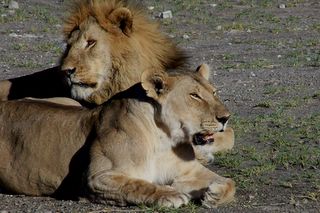
This male and female lion pair live near a stream in the Serengeti, a huge plains area in Tanzania. All types of animals live on the plains and migrate through each year. The plains are a reserve area designated by the Tanzanian government and providing total protection to the animals from hunters.
Other lions belong to the pride (family) of the pictured pair. Several prides of lions live in this area. When a lion roars, he or she can be heard from miles away. Imagine what it would sound like if they were just outside your tent?!
Saturday, July 30, 2005
Wildebeest on Serengeti Plains
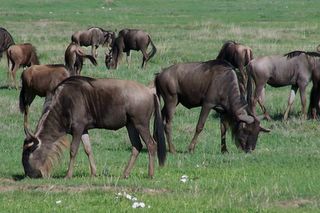
These Wildebeest live on the Serengeti plains in Tanzania, though they migrate northward into Kenya once a year. There are more than one million Wildebeest who move each year. And they all move together. It's quite amazing to see so many animals moving together. You can see the migration on TV on channels like the Disovery channel or Animal Planet.
Friday, July 29, 2005
Ngorongora Crater, Tanzania
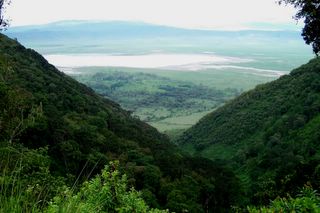
You can see why this gorgeous crater attracts all types of animals. The lake at the bottom provides water. Some of the animals that live here are: elephants, lions, hyenas, warthogs, zebra, waterbucks, Impala, gazelle, cheetah, leopards, hippos and wildebeest.
This area is not really a crater. It was once a volcano but has collapsed in on itself over millions of years. Flamingoes live on the lake's edge and create quite a sight when they flock together.
Thursday, July 28, 2005
Samuel the Guard (Escary)

This is the compound where I live in Kisumu, Kenya. The Ruprahs live in the main house and I rent their same house in the back. Samuel is the supervisor of the guards who secure the purple gate in the background. In Kiswahili, the word for guard is "escary," pronounced es-scar-re. Samuel only lets people into the compound who belong here. The gate is usually chained and padlocked. In addition to being the guard, Samuel also keeps the yard clean. You can see in his hand a homemade broom. He has tied pieces of leafy branches to a stick and he uses this to sweep up leaves (see the pile of brown leaves) and seeds that drop from the trees onto the cement.
The tree growing in the foreground on the left is a Papaya tree. It's too young to bear fruit, but in a year or two, the tree will be 15 or 20 feet tall. Big, green Papayas will grow in bunches under the top grouping of leaves. The bark forms a beautiful honeycomb pattern when the trees grow up. In Kenya, they call a Papaya a Popo, pronunced po-po.
Wednesday, July 27, 2005
Cows on Kisumu Streets

People who live in Kisumu keep cows. Every day, we pass herds of cows on paved city streets (and dirt streets, too). Each herd is tended by someone who walks with the cows as they look for grass to eat. Usually there will be goats, too, and sheep. It feels strange (and sometimes a little scary) to be walking down the street and have a group of cows pass on either side of you. They're awfully nice, though, and never bump people. But if they have horns, we must stand clear. If they have an itch they want to bite and swing their head around, they could knock a passerby with their long horns!
Tuesday, July 26, 2005
Cheetah in Ngorongora Crater, Tanzania

When we went on safari to see animals in Ngorongora Crater, Tanazania, our guide told us it is unusual to see Cheetah. So we didn't get our hopes up. But to our delight, we did see Cheetahs that day! Four of them, together in the grass. Because it was so hot that day, the Cheetahs came up to our jeeps and wanted to lie in the shade of the car.
This Cheetah walked right up to our vehicle so I was able to get photos from a few feet away. This guy (or gal!) laid under our jeep, next to the back tire, for about 20 minutes. When another jeep cranked their engine to leave, it scared the poor Cheetah and he ran back into the grass field.
Monday, July 25, 2005
Hippo in Lake Victoria

This big guy lives in Lake Victoria and is the protector of his family. When our boat floated close to the group of hippos, all the others went under the water, except for this guy. He stayed with his eyes up, watching us, to make sure we did not get too close to his loved ones.
We were in a wooden boat with three men who used oars instead of a motor. When the men wanted to attract the hippos so we could see them, they rapped their oars on the edge of the boat. This did get the hippo's attention, as you can see in the photo. But we didn't get too close!! Hippos can bite a hole in a boat if they feel threatened.
Sunday, July 24, 2005
Young Maasai Warrior, Tanzania

This young warrior lives with his extended family in Tanzania. He has been trained to guard their home from lions and other wild animals that might harm their cows, sheeps, goats and donkeys.
I met two Maasai warriors on the road today while walking into Kisumu. They were talking to a boda boda driver (a man who rides people on his bike for a small fee). I hired the boda boda to take me to town. He said the Maasai men were asking him to teach them how to ride a bike! Maasai are pastoralists, which means their tribe has traditionally raised cows, sheep and goats. For hundreds, maybe thousands, of years, the Maasai have moved about the countryside looking for grass for their herds.
When tending to their herds, the Maasai walk, they don't ride bicycles. It's nice these two young Maasai men want to learn something new.
Saturday, July 23, 2005
Train in Kenya Countryside

When the British governed Kenya, they built railways from Mombasa, on the coast of Kenya, to Nairobi, the capital city of Kenya. They ran the railroad to Kisumu, on Lake Victoria, and then northwest into Uganda, to its captial city of Kampala. The railroad was built in the late 1800's and reached Kisumu in 1902. It's now 100 years old! People from India came over to help with the building of the railroads. Many of them stayed in Kenya and their descendants now make up the population of Asians found living throughout the country.
The trains still run over the rails laid by the British and Indian workers. This photo was taken from a car toward the end of the train, or the red caboose (the last car). The countryside is Kenya as the train nears Mombasa. It's fun to take the overnight train from Nairobi to Mombasa. The trip takes 14 hours with lots of stops along the way.

